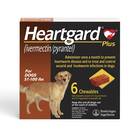Everything You Need To Know About Tapeworms In Dogs
Tapeworms are so gross 🪱

Finding out your dog has tapeworms can be pretty scary — especially after seeing tiny pieces of worm in his poop. (Ew!)
But there’s really no need to panic. Tapeworms really only cause your dog minor issues and are pretty easy to treat.
The Dodo spoke with Dr. Bernadine Cruz, a veterinarian with Laguna Hills Animal Hospital in California, to find out everything you need to know about how tapeworms affect dogs.
What are tapeworms in dogs?
“Tapeworms are a type of internal parasite,” Dr. Cruz told The Dodo. They live in your dog’s small intestine, latching onto the walls using their mouths.
It sounds invasive and harmful and all-around awful, but these parasites aren’t typically dangerous at all.
“Adult tapeworms usually are considered to not be problematic for pets,” Dr. Cruz said.
However, if you notice tapeworms in your dog’s poop, you should still bring him to the veterinarian so he can be treated.
Tapeworms in dog poop
The nastiest thing about tapeworms is that you can actually see them in your pup’s poop.
“Tapeworm segments are passed in the stool,” Dr. Cruz said. “They can resemble a grain of rice due to their size and creamy color. When dried, they resemble a sesame seed.”
Spotting a tapeworm segment is actually the most effective way to diagnose your dog with a tapeworm infection.
“Tapeworms are best diagnosed by identifying the small segments (aka proglottids) that will be on the surface of freshly passed feces,” Dr. Cruz said. “A fecal analysis can be performed, but often has negative results because the segments that are passed are not identified with the typical fecal floatation technique used by commercial labs. Visualization is the best method.”
Sometimes it’s not just the segments that make an appearance, but the whole worm.
“Occasionally they may spontaneously crawl out of a pet's rectum to be found on the fur by their rectum, where they have been sitting or [on] an owner's lap,” Dr. Cruz said. “They are mobile when they freshly emerge and inch along slowly.”
How do dogs get tapeworms?
Dogs get tapeworms from fleas — as if the little bugs weren’t already annoying enough.
“Infection ... comes from the ingestion of adult fleas that are infected with tapeworm larvae,” Dr. Cruz said.
Here’s how it works: A flea eats a tapeworm egg. Your dog eats the flea. When your dog digests the flea, the tapeworm egg is released from the flea and ultimately hatches in your pup’s gastrointestinal system. That’s when the worm will latch onto his small intestine.
Can humans get tapeworms from dogs?
If you’re worried you might catch your dog’s tapeworms, don’t — since you can’t get tapeworms from your dog.
“Tapeworms are not directly contagious from dogs and cats to people,” Dr. Cruz said. “A person would need to swallow fleas in order to become a host.”
So If you spot tapeworm segments in your pup’s poop, don’t worry about picking up a hitchhiker yourself.
Tapeworm symptoms in dogs
There aren’t really a ton of symptoms that pop up if your dog has tapeworms.
“[The] most common side effect of an infestation is anal itch,” Dr. Cruz said.
Another telltale symptom of a tapeworm infection is anal scooting. You know, when your dog decides to slide his butt all over your floor.
In more serious cases, your pup might experience some weight loss. But overall, tapeworms are not considered to be dangerous for dogs.
Tapeworm prevention for dogs
The only real way to prevent your dog from getting a tapeworm infection is to keep the fleas at bay, since that’s how your dog would get tapeworms in the first place.
“Flea control is the only way to prevent this issue,” Dr. Cruz said.
A lot of flea prevention options are combination medications that can ward off ticks, too.
Try K9 Advantix II from Amazon for $15.98+
(That one’s for small dogs, but it’s also available for medium, large and extra-large pups.)
Tapeworm treatment for dogs
Tapeworm treatment is easy since prescription deworming medication is pretty effective.
But according to Dr. Cruz, you shouldn’t reach for an over-the-counter (OTC) dewormer at the pet store since those are more effective against other parasites — and not tapeworms.
“Outpatient anthelmintic treatment with medication dispensed by a veterinarian is best,” Dr. Cruz said. “It is not recommended to use over-the-counter products. The majority of OTC dewormers are for roundworms and not tapeworms.”
So if your dog’s got a tapeworm, you really don’t need to be stressed at all, maybe just a little grossed out. They aren’t super harmful to your pup and can’t be passed to you.
Plus a quick trip to the vet should have the infection cleared up in no time.
We independently pick all the products we recommend because we love them and think you will too. If you buy a product from a link on our site, we may earn a commission.





